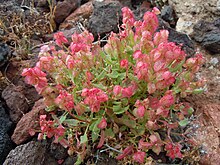Rumex vesicarius, also known as Ruby dock,[4] or bladder dock,[3] is a species of perennial[verification needed] flowering plant in the family Polygonaceae.[3] According to Plants of the World Online, Rumex vesicarius is native to tropical and temperate Asia, Africa, and Western Australia.[3] However, the Council of Heads of Australasian Herbaria asserts that within Australia it is naturalised in Western Australia, the Northern Territory, South Australia, Queensland and New South Wales.[5]
| Rumex vesicarius | |
|---|---|

| |

| |
| Cultivar | |
| Scientific classification | |
| Kingdom: | Plantae |
| Clade: | Tracheophytes |
| Clade: | Angiosperms |
| Clade: | Eudicots |
| Order: | Caryophyllales |
| Family: | Polygonaceae |
| Genus: | Rumex |
| Species: | R. vesicarius
|
| Binomial name | |
| Rumex vesicarius | |
| Synonyms[3] | |
Description edit
It is an erect, succulent annual[verification needed] herb which grows to up about 60 cm high, and has triangular to ovate leaves which are truncate or cordate at the base and about 5–10 cm long,[6] with entire margins.[7] The stipules form an almost complete sheath around the stem which disintegrates. The flowers are green with a red tinge, and have six perianth segments with the inner three becoming enlarged and papery when fruiting. The hard, red and reticulately veined fruit persist,[7] giving rise to spectacular displays.[6]
Etymology edit
The specific epithet, vesicarius, derives from the Latin word, vesica, meaning "bladder", to give an adjective which describes the fruit of the plant as "inflated", "bladder-like".[8]
References edit
- ^ "Rumex vesicarius". Australian Plant Name Index, IBIS database. Centre for Plant Biodiversity Research, Australian Government.
- ^ Linnaeus, C. (1753) Species Plantarum 1: 336
- ^ a b c d "Rumex vesicarius L. | Plants of the World Online | Kew Science". Plants of the World Online. Retrieved 6 January 2020.
- ^ Western Australian Herbarium, Biodiversity and Conservation Science. "Rumex vesicarius: FloraBase—the Western Australian Flora". florabase.dpaw.wa.gov.au. Retrieved 6 January 2020.
- ^ "Rumex vesicarius". biodiversity.org.au. Retrieved 6 January 2020.
- ^ a b "Acetosa vesicaria: Flora of Victoria". vicflora.rbg.vic.gov.au. Retrieved 6 January 2020.
- ^ a b "Acetosa vesicaria (NT Flora)". eflora.nt.gov.au. Retrieved 6 January 2020.
- ^ "vesicarius,-a,-um". www.plantillustrations.org. Retrieved 6 January 2020.
External links edit
- Media related to Rumex vesicarius at Wikimedia Commons
- Data related to Rumex vesicarius at Wikispecies
- Rumex vesicarius Occurrence data from GBIF
- "Rumex vesicarius". Plants for a Future.